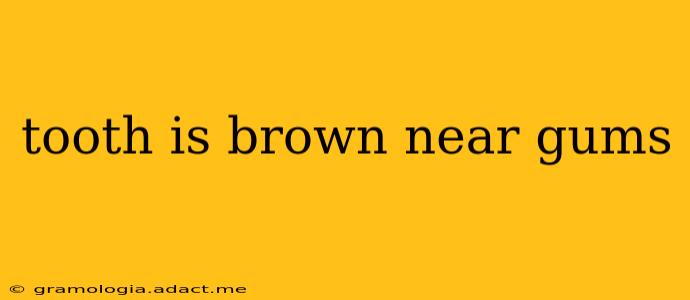Discovering a brown discoloration near your gum line can be alarming. While it might seem like a minor cosmetic issue, a brown tooth near the gums can signal various underlying dental problems. Understanding the potential causes is crucial for timely intervention and preventing further damage. This comprehensive guide will explore the reasons behind this discoloration, available treatments, and preventative measures you can take.
What Causes a Brown Tooth Near the Gums?
Several factors can contribute to a brown discoloration near the gum line. These range from simple staining to more serious dental conditions. Let's examine some of the most common causes:
1. Dental Staining:
- External Stains: These are the most common culprits. Foods and drinks like coffee, tea, red wine, and even certain berries can leave behind pigments that accumulate over time, particularly near the gum line where brushing might be less thorough. Tobacco use is another significant contributor to external staining.
- Internal Stains: These stains originate within the tooth itself, often due to aging, trauma, or certain medications. Tetracycline antibiotics, for instance, can cause intrinsic discoloration, especially in developing teeth.
2. Gum Recession:
As gums recede, they expose more of the tooth's root surface. This root surface is naturally more porous and yellowish than the enamel, making it more susceptible to staining. The exposed dentin might appear brownish, particularly if staining is present.
3. Tooth Decay (Cavities):
Cavities, or dental caries, are caused by bacteria that produce acids which erode tooth enamel. As the decay progresses, it can discolor the affected area, often appearing brown or black near the gum line.
4. Dental Fluorosis:
While fluoride is essential for strong teeth, excessive fluoride intake during tooth development can cause fluorosis. This manifests as white or brown spots or streaks on the tooth enamel, often concentrated near the gum line.
5. Trauma:
Injury to a tooth can lead to internal discoloration. A blow to the mouth, for instance, can damage the tooth's pulp, causing it to darken over time.
How is a Brown Tooth Near the Gums Treated?
The treatment for a brown tooth near the gums depends heavily on the underlying cause.
1. Professional Teeth Cleaning:
For external stains, a professional cleaning by a dentist or hygienist can significantly improve the appearance of your teeth. They use specialized tools and techniques to remove surface stains more effectively than at-home brushing and flossing.
2. Teeth Whitening:
Teeth whitening treatments, either in-office or at-home, can lighten discolored teeth. However, the effectiveness varies depending on the type and severity of the discoloration. Internal stains are often less responsive to whitening treatments.
3. Dental Bonding:
In cases of minor discoloration or minor chips, dental bonding can effectively restore the tooth's aesthetic appearance. A composite resin material is applied to the tooth and shaped to match the surrounding enamel.
4. Porcelain Veneers:
For more severe discoloration or significant cosmetic imperfections, porcelain veneers might be recommended. These thin shells are bonded to the front surface of the teeth, masking underlying discoloration and improving the overall appearance.
5. Root Canal Treatment:
If the discoloration is due to decay or damage to the tooth's pulp, a root canal may be necessary. This procedure removes the infected or damaged pulp, cleans the tooth, and fills it to prevent further infection. After a root canal, the tooth may still require a crown or other cosmetic restoration.
How Can I Prevent a Brown Tooth Near the Gums?
Prevention is key to maintaining healthy, bright teeth. Here are some practical tips:
- Maintain Excellent Oral Hygiene: Brush twice daily with fluoride toothpaste, floss daily, and use an antimicrobial mouthwash.
- Limit Staining Foods and Drinks: Reduce your consumption of coffee, tea, red wine, and tobacco products. If you do consume these, rinse your mouth with water afterward.
- Regular Dental Checkups: Schedule regular checkups and cleanings with your dentist to catch and address any dental problems early on.
- Avoid Trauma: Wear a mouthguard during sports or activities that might cause mouth injuries.
What if the Brown Discoloration is accompanied by pain or sensitivity?
Pain or sensitivity near the brown discoloration warrants immediate attention from your dentist. This could indicate a more serious underlying problem like decay, infection, or gum disease requiring prompt treatment.
Can home remedies whiten a brown tooth near the gums?
While some home remedies, such as oil pulling, might offer mild benefits, they are unlikely to effectively address significant brown discoloration. Professional dental treatments are generally more effective and safer.
Is a brown tooth near the gums always a sign of a problem?
Not necessarily. In some cases, it could simply be due to external staining. However, it's always best to consult your dentist to rule out any underlying dental issues. Early detection and treatment are crucial for preventing more extensive problems.
By understanding the causes, treatments, and preventative measures, you can take proactive steps to maintain a healthy and aesthetically pleasing smile. Remember to consult your dentist for a proper diagnosis and personalized treatment plan.
